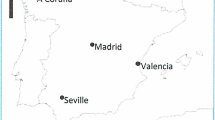Abstract
There are several cases where a circular variable is associated with a linear one. A typical example is wind direction that is often associated with linear quantities such as air temperature and air humidity. The analysis of a statistical relationship of this kind can be tested by the use of parametric and non-parametric methods, each of which has its own advantages and drawbacks. This work deals with correlation analysis using both the parametric and the non-parametric procedure on a small set of meteorological data of air temperature and wind direction during a summer period in a Mediterranean climate. Correlations were examined between hourly, daily and maximum-prevailing values, under typical and non-typical meteorological conditions. Both tests indicated a strong correlation between mean hourly wind directions and mean hourly air temperature, whereas mean daily wind direction and mean daily air temperature do not seem to be correlated. In some cases, however, the two procedures were found to give quite dissimilar levels of significance on the rejection or not of the null hypothesis of no correlation. The simple statistical analysis presented in this study, appropriately extended in large sets of meteorological data, may be a useful tool for estimating effects of wind on local climate studies.
Similar content being viewed by others
References
Batscelet E (1981) Circular statistics in biology. Academic Press Inc. Ltd, London
Droulia F, Lykoudis S, Tsiros IX, Alvertos N, Akylas E, Garofalakis I (2009) Ground temperature estimations using simplified analytical and semi-empirical approaches. Sol Energy 83:211–219
Fernández-Durán JJ (2007) Models for circular-linear and circular-circular data constructed from circular distributions based on nonnegative trigonometric sums. Biometrics 63:579–585
Founda D, Giannakopoulos C (2009) The exceptionally hot summer of 2007 in Athens, Greece. A typical summer in the future climate? Glob Planet Change 67:227–236
García-Portugués E, Crujeiras RM, González-Manteiga W (2013) Exploring wind direction and SO2 concentration by circular-linear density estimation. Stoch Environ Res Risk Assess 27:1055–1067
Jammalamadaka SR, Lund UJ (2006) The effect of wind direction on ozone levels: a case study. Environ Ecol Stat 13:287–298
Mardia K (1976) Linear-circular correlation coefficients and rhythmometry. Biometrika 63:403–405
Mardia K, Jupp P (2000) Directional statistics. Wiley, New Jersey
Maurer SB, Ralston A (2004) Discrete algorithmic mathematics. A K Peters/CRC Press, Boca Raton
Oriana V2.02a (2004) Kovach computing services. http://www.kovcomp.co.uk. Accessed 9 Feb 2017
Pérez IA, Ángeles M, García MA, Sánchez L, de Torre B (2007) Analysis of directional meteorological data by means of cylindrical models. Renew Energy 32:459–473
SenGupta A, Ugwuowo FI (2006) Asymmetric circular-linear multivariate regression models with applications to environmental data. Environ Ecol Stat 13:299–309
Shashua-Bar L, Tsiros I, Hoffman M (2010) A modeling study for evaluating the thermal regime of passive cooling scenarios in urban streets. Case study: Athens, Greece. Build Environ 45:2798–2807
Shashua-Bar L, Tsiros I, Hoffman ME (2012) Passive cooling design options to ameliorate thermal comfort in urban streets of a Mediterranean climate (Athens) under hot summer conditions. Build Environ 57:110–119
Solow A, Bullister J, Nevison S (1988) An application of circular-linear correlation analysis to the relationship between freon concentration and wind direction in Woods Hole Massachusetts. Environ Monit Assess 10:219–228
Tsiros IX, Hoffman ME (2014) Thermal and comfort conditions in a rear wooded garden and its adjacent semi-open spaces in a Mediterranean climate (Athens) during summer. Archit Sci Rev 57:63–82
Acknowledgements
The authors wish to thank the three anonymous reviewers for their careful review and also for their insightful suggestions, which led to a substantial improvement of the original manuscript.
Author information
Authors and Affiliations
Corresponding author
Additional information
Responsible Editor: J.-F. Miao.
Rights and permissions
About this article
Cite this article
Lototzis, M., Papadopoulos, G.K., Droulia, F. et al. A note on the correlation between circular and linear variables with an application to wind direction and air temperature data in a Mediterranean climate. Meteorol Atmos Phys 130, 259–264 (2018). https://doi.org/10.1007/s00703-017-0508-y
Received:
Accepted:
Published:
Issue Date:
DOI: https://doi.org/10.1007/s00703-017-0508-y




